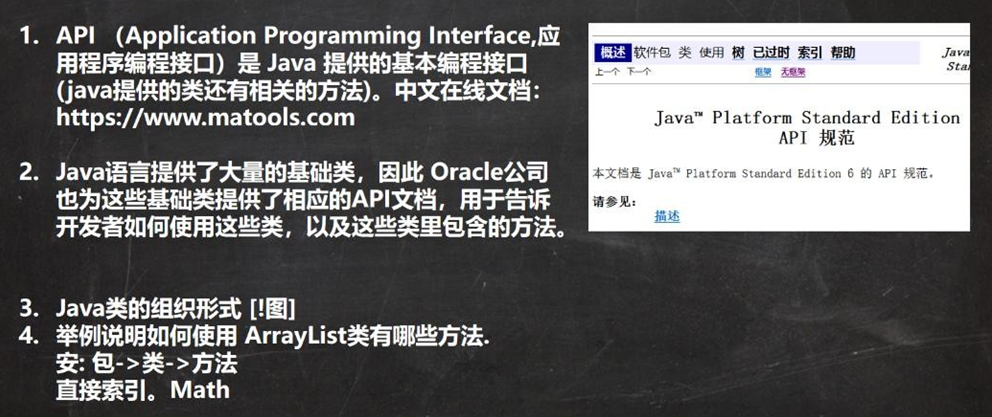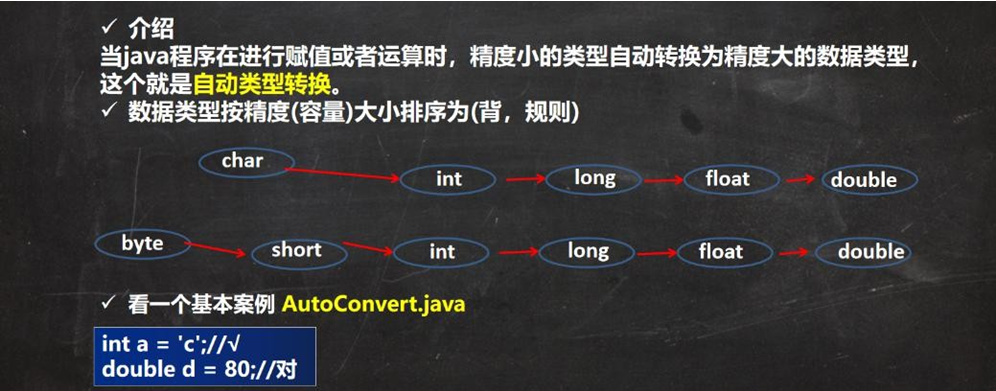变量的基本使用
声明变量
int a;
赋值
a = 60; //应该这么说: 把 60 赋给 a
使用 System.out.println(a);
也可以一步到位 int a = 60; 通常我们是一步完成
public class Var01 {//编写一个main方法public static void main(String[] args) {//声明变量int a;a = 100;System.out.println(a);//还可以这样使用int b = 800;System.out.println(b);}}
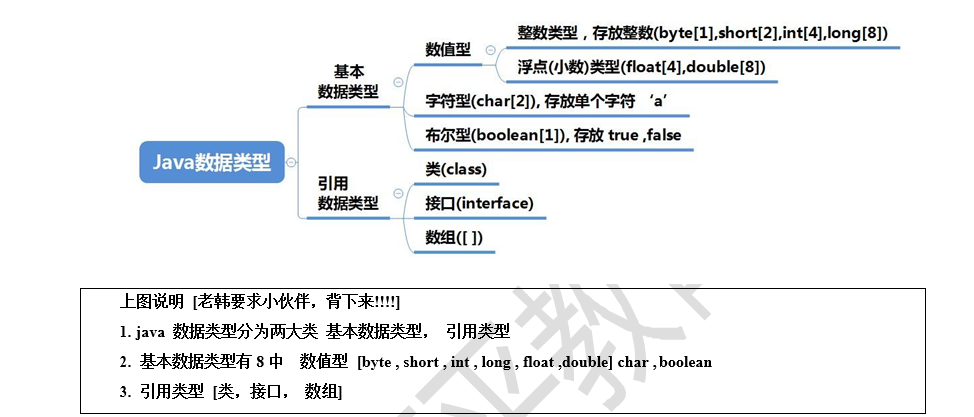
public class Var02 {//编写一个main方法public static void main(String[] args) {//记录人的信息int age = 30;double score = 88.9;char gender = '男';String name = "king";//输出信息, 快捷键System.out.println("人的信息如下:");System.out.println(name);System.out.println(age);System.out.println(score);System.out.println(gender);}}
变量注意事项

变量的细节
public class VarDetail {//编写一个main方法public static void main(String[] args) {//变量必须先声明,后使用, 即有顺序int a = 50;//intSystem.out.println(a);//50//该区域的数据/值可以在同一类型范围内不断变化//a = "jack"; //× a是整型 不能在赋值字符串a = 88; //对 变量可以重新赋值System.out.println(a);//88//变量在同一个作用域内不能重名//int a = 77;//错误}}class Dog {public static void main(String[] args) {int a = 666;//对 因为在Dog这个作用域中 没有在vardetail中 不在同一个作用域 不冲突}}
程序中 +号的使用

public class Homework01 {//编写一个main方法public static void main(String[] args) {int n1;n1 = 13;int n2;n2 = 17;int n3;n3 = n1 + n2;System.out.println("n3 = " + n3);//30int n4 = 38;int n5 = n4 - n3;System.out.println("n5 = " + n5);//8}}
数据类型
整数类型

public class IntDetail {//编写一个main方法public static void main(String[] args) {//Java的整型常量(具体值)默认为 int 型,声明long型常量须后加‘l’或‘L’int n1 = 1;//4个字节//int n2 = 1L;//不对 无法把long型放入int中 放不下long n3 = 1L;//对}}
浮点类型
Java的浮点类型可以表示一个小数
float是单精度类型,精度是8位有效数字,取值范围是10的-38次方到10的38次方,float占用4个字节的存储空间
double是双精度类型,精度是17位有效数字,取值范围是10的-308次方到10的308次方,double占用8个字节的存储空间
默认小数都用double来表示,所以如果要用float的话,则应该在其后加上f
public class FloatDetail {//编写一个main方法public static void main(String[] args) {//Java 的浮点型常量(具体值)默认为double型,声明float型常量,须后加‘f’或‘F'//float num1 = 1.1; //错误 默认是double 8个字节 无法将8个字节的小数放到4个字节的folat存储空间中float num2 = 1.1F; //对的double num3 = 1.1; //对double num4 = 1.1f; //对//十进制数形式:如:5.12 512.0f .512 (必须有小数点)double num5 = .123; //等价 0.123 点前面的0可以省掉调System.out.println(num5);//科学计数法形式:如:5.12e2 [5.12 * 10的2次方 ] 5.12E-2 []System.out.println(5.12e2);//512.0System.out.println(5.12E-2);//0.0512 5.12*10 -2次方//通常情况下,应该使用double型,因为它比float型更精确。//[举例说明]double num9 = 2.1234567851;float num10 = 2.1234567851F;double num9 = 2.1234567851;float num10 = 2.1234567851F;System.out.println(num9); //2.1234567851System.out.println(num10); //2.1234567}}
浮点型陷阱
public class floatdetail {//编写一个main方法public static void main(String[] args) {//浮点数使用陷阱: 2.7 和 8.1 / 3 比较//看看一段代码double num11 = 2.7; //输出2.7double num12 = 8.1 / 3; // 输出 2.6999999999999997System.out.println(num11);System.out.println(num12);//接近2.7的一个小数,而不是2.7//得到一个重要的使用点: 当我们对运算结果是小数的进行相等判断是,要小心//应该是以两个数的差值的绝对值,在某个精度范围类判断if( num11 == num12) {System.out.println("num11 == num12 相等");} //不会输出结果 因为num11 不等于num12//比较计算出来的值正确的写法if(Math.abs(num11 - num12) < 0.000001 ) {System.out.println("差值非常小,到我的规定精度,认为相等...");}// 可以通过java API math.abs 比较两个数值绝对值的差值System.out.println(Math.abs(num11 - num12));//细节:如果是直接查询得的的小数或者直接赋值,是可以判断相等}}
关于浮点数在机器中存放形式的简单说明,浮点数=符号位+指数位+尾数位
尾数部分可能丢失,造成精度损失(小数都是近似值)。
符号位
在最高二进制位上分配1位表示浮点数的符号,0表示正数,1表示负数。
指数位
在符号位右侧分配8位用来存储指数
尾数位
最右侧分配连续23位用来存储有效数字
java api
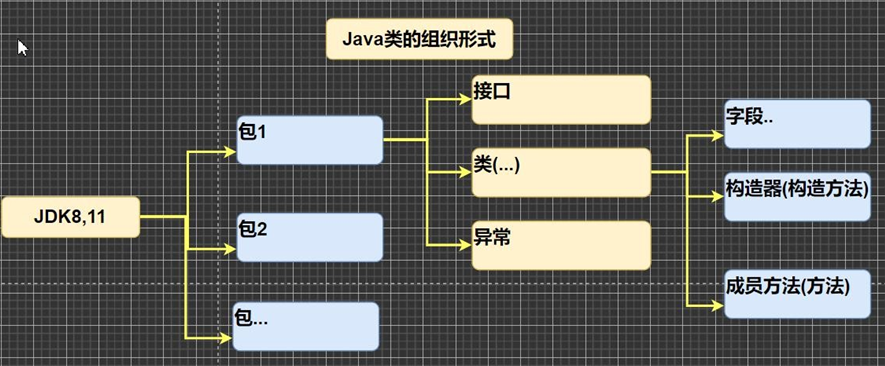
字符类型char
字符类型可以表示单个字符,字符类型是 char,char 是两个字节(可以存放汉字)
//演示char的基本使用public class Char01 {//编写一个main方法public static void main(String[] args) {char c1 = 'a';char c2 = '\t';char c3 = '韩';char c4 = 97; //说明: 字符类型可以直接存放一个数字// 输出c4的时候 会输出97对应的ASSIC码对应的字符 aSystem.out.println(c1);System.out.println(c2);System.out.println(c3);System.out.println(c4);//当输出c4时候,会输出97表示的字符 => 编码的概念}}
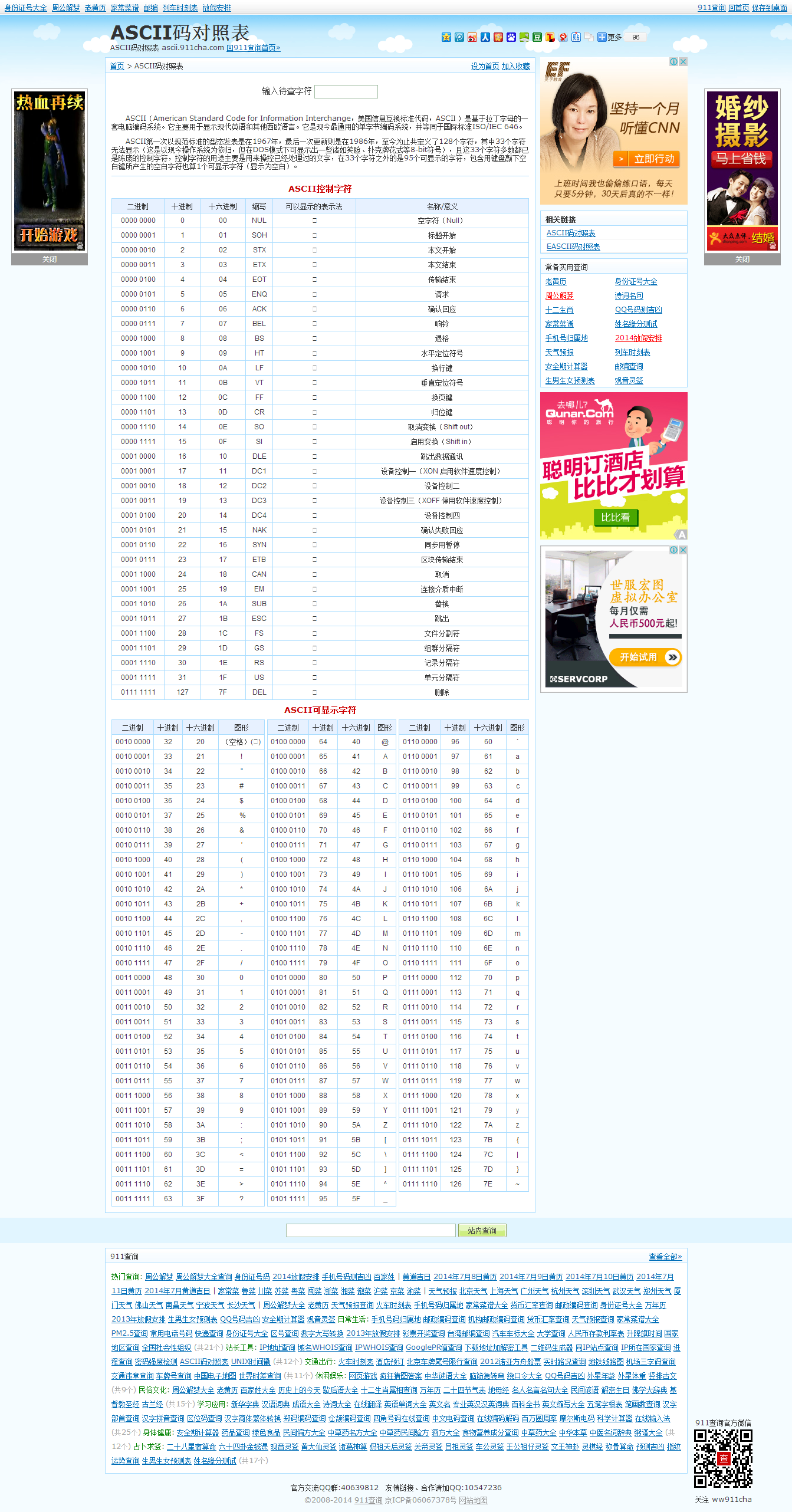
字符类型使用细节
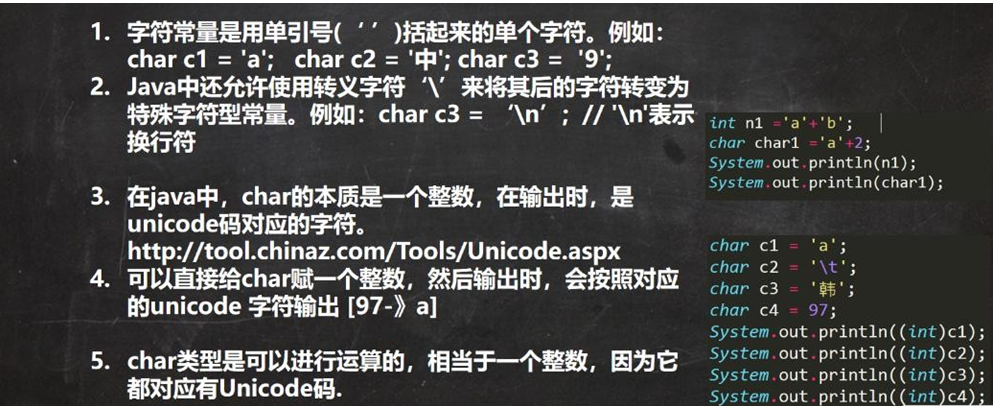
public class CharDetail {//编写一个main方法public static void main(String[] args) {//在java中,char的本质是一个整数,在默认输出时,是unicode码对应的字符//要输出对应的数字,可以(int)字符char c1 = 97;System.out.println(c1); // achar c2 = 'a'; //输出'a' 对应的 数字System.out.println((int)c2);//输出 97char c3 = '韩';System.out.println((int)c3);//38889char c4 = 38889;System.out.println(c4);//韩//char类型是可以进行运算的,相当于一个整数,因为它都对应有Unicode码.System.out.println('a' + 10);//107 字符于数字运算 得到的是字符对应的数字与数字的相加//课堂小测试char c5 = 'b' + 1;//98+1==> 99System.out.println((int)c5); //99System.out.println(c5); //99->对应的字符->编码表ASCII(规定好的)=>c//输出99在编码表ASCII 表中对应的汉字}}
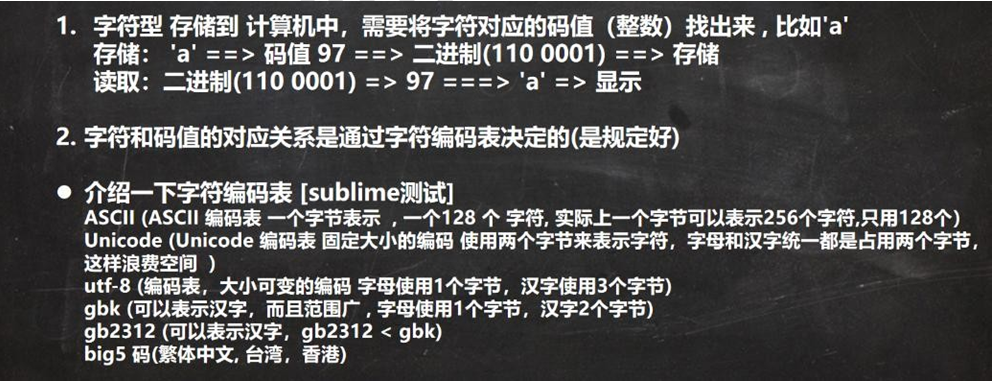
unicode介绍
utf-8介绍
布尔类型boolean
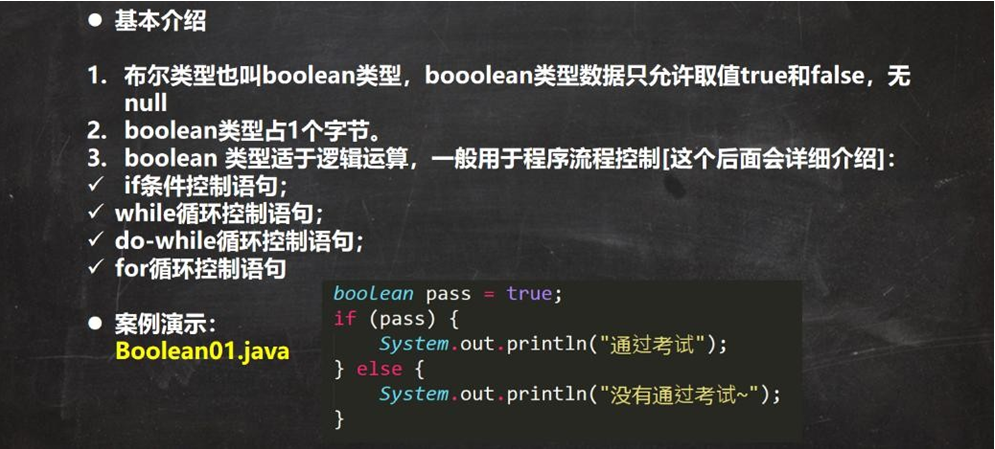
public class Boolean01 {//编写一个main方法public static void main(String[] args) {//演示判断成绩是否通过的案例//定义一个布尔变量boolean isPass = true;if(isPass == true) {System.out.println("考试通过,恭喜");} else {System.out.println("考试没有通过,下次努力");}}}
基本数据类型转换
自动类型转换注意和细节
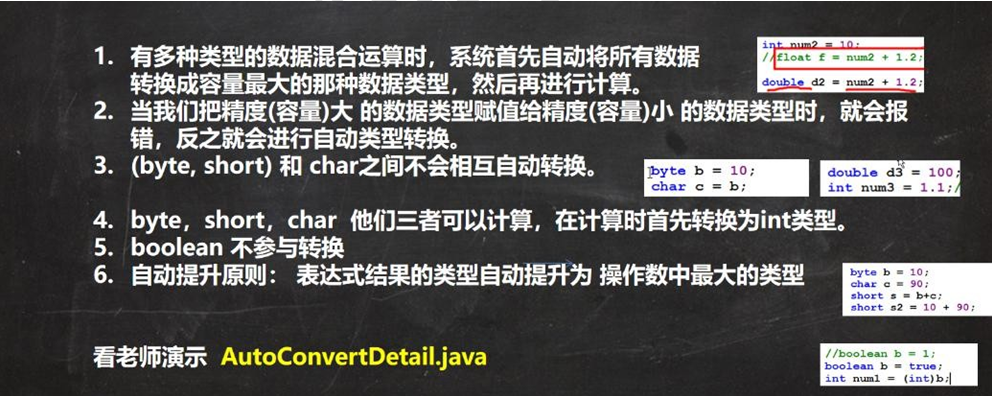
public class AutoConvert {//编写一个main方法public static void main(String[] args) {//演示自动转换int num = 'a';//ok char -> intdouble d1 = 80; //ok int -> doubleSystem.out.println(num);//97System.out.println(d1);//80.0//}}
数据类型转换细节
//自动类型转换细节public class AutoConvertDetail {//编写一个main方法public static void main(String[] args) {//细节1: 有多种类型的数据混合运算时,//系统首先自动将所有数据转换成容量最大的那种数据类型,然后再进行计算int n1 = 10; //ok//float d1 = n1 + 1.1;//错误 1.1小数默认是double类型 n1 + 1.1 => 结果类型是 double double->folat不可以//double d1 = n1 + 1.1;//对 n1 + 1.1 => 结果类型是 doublefloat d1 = n1 + 1.1F;//对 n1 + 1.1 => 结果类型是 float//细节2: 当我们把精度(容量)大 的数据类型赋值给精度(容量)小 的数据类型时,//就会报错,反之就会进行自动类型转换。////int n2 = 1.1;//错误 double -> int//细节3: (byte, short) 和 char之间不会相互自动转换//当把具体数赋给 byte 时,(1)先判断该数是否在byte范围内,如果是就可以byte b1 = 10; //对 , -128-127// int n2 = 1; //n2 是int// byte b2 = n2; //错误,原因: 如果是变量赋值,判断类型 n2 int4个字节 byte 1个字节//// char c1 = b1; //错误, 原因 byte 不能自动转成 char//////细节4: byte,short,char 他们三者可以计算,在计算时首先转换为int类型byte b2 = 1;byte b3 = 2;short s1 = 1;//short s2 = b2 + s1;//错, b2 + s1 => int 整数默认是intint s2 = b2 + s1;//对, b2 + s1 => int//byte b4 = b2 + b3; //错误: b2 + b3 => int////boolean 不参与转换boolean pass = true;//int num100 = pass; // boolean 不参与类型的自动转换//自动提升原则: 表达式结果的类型自动提升为 操作数中最大的类型//看一道题byte b4 = 1;short s3 = 100;int num200 = 1;float num300 = 1.1F;double num500 = b4 + s3 + num200 + num300; //float -> double}}
强制类型转换
也就是把之前不能转的 通过强制的方法转过去
将容量大的数据类型转换为容量小的数据类型。使用时要加上强制转换符( ),但可能造成精度降低或溢出,格外要注意。
public class ForceConvert {//编写一个main方法public static void main(String[] args) {//演示强制类型转换int n1 = (int)1.9; //强制吧1.9double类型转成intSystem.out.println("n1=" + n1);//1, 造成精度损失int n2 = 2000;byte b1 = (byte)n2;System.out.println("b1=" + b1);//造成 数据溢出 b1=-48}}
强制类型转换细节说明

public class ForceConvertDetail {//编写一个main方法public static void main(String[] args) {//演示强制类型转换//强转符号只针对于最近的操作数有效,往往会使用小括号提升优先级//int x = (int)10*3.5+6*1.5;//编译错误: double -> int 只把10强转换为int 计算结果是double转int报错int x = (int)(10*3.5+6*1.5);// (int)44.0 -> 44 把整个后面括号内的值强转System.out.println(x);//44char c1 = 100; //okint m = 100; //ok//char c2 = m; //错误char c3 = (char)m; //okSystem.out.println(c3);//100对应的字符, d字符}}
public class Homework01 {//编写一个main方法public static void main(String[] args) {int n1;n1 = 13;int n2;n2 = 17;int n3;n3 = n1 + n2;System.out.println("n3 = " + n3);//30int n4 = 38;int n5 = n4 - n3;System.out.println("n5 = " + n5);//8}}
基本数据类型和String 类型的转换
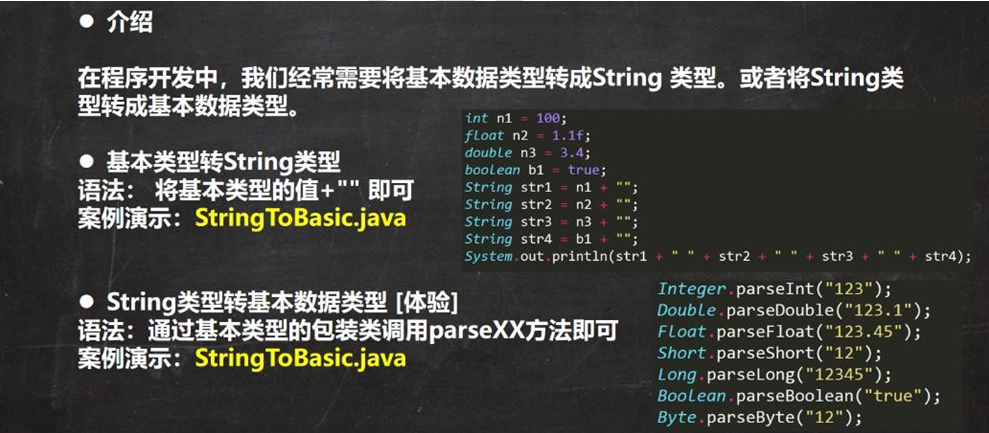
public class StringToBasic {//编写一个main方法public static void main(String[] args) {//基本数据类型->Stringint n1 = 100;float f1 = 1.1F;double d1 = 4.5;boolean b1 = true;String s1 = n1 + "";String s2 = f1 + "";String s3 = d1 + "";String s4 = b1 + "";System.out.println(s1 + " " + s2 + " " + s3 + " " + s4);//String->对应的基本数据类型String s5 = "123";//会在OOP 讲对象和方法的时候回详细//解读 使用 基本数据类型对应的包装类,的相应方法,得到基本数据类型int num1 = Integer.parseInt(s5);double num2 = Double.parseDouble(s5);float num3 = Float.parseFloat(s5);long num4 = Long.parseLong(s5);byte num5 = Byte.parseByte(s5);boolean b = Boolean.parseBoolean("true");//布尔类型只能转成True Falseshort num6 = Short.parseShort(s5);System.out.println("===================");System.out.println(num1);//123System.out.println(num2);//123.0System.out.println(num3);//123.0System.out.println(num4);//123System.out.println(num5);//123System.out.println(num6);//123System.out.println(b);//true//怎么把字符串转成字符char -> 含义是指 把字符串的第一个字符得到//解读 s5.charAt(0) 得到 s5字符串的第一个字符 '1'System.out.println(s5.charAt(0)); //根据下标转换}}
基本数据类型和String 类型的转换细节
在将 String 类型转成 基本数据类型时, 要确保string类型能够转换成有效的数据 ,
比如 我们可以把 “123” , 转成一个整数,但是不能把 “hello” 转成一个整数
/*** 演示字符串转基本数据类型的细节*/public class StringToBasicDetail {//编写一个main方法public static void main(String[] args) {String str = "hello";//编译并不会报错 因为没有语法错误 但是执行的时候会报错//转成intint n1 = Integer.parseInt(str);System.out.println(n1);}}
如果格式不正确,就会抛出异常,程序就会终止
**
public class Homework02 {//±àдһ¸ömain·½·¨public static void main(String[] args) {char c1 = '\n';char c2 = '\t';char c3 = '\r';char c4 = '\\';char c5 = '1';char c6 = '2';char c7 = '3';System.out.println(c1);System.out.println(c2);System.out.println(c3);System.out.println(c4);System.out.println(c5);System.out.println(c6);System.out.println(c7);}}
public class Homework03 {//编写一个main方法public static void main(String[] args) {//编程,保存两本书名,用+拼接,看效果。保存两个性别,//用加号拼接,看效果。保存两本书价格,用加号拼接,看效果String book1 = "天龙八部";String book2 = "笑傲江湖";System.out.println(book1 + book2);//天龙八部笑傲江湖//性别应该使用char保存char c1 = '男';char c2 = '女';System.out.println(c1 + c2);//得到 男 字符码值 + 女 字符码值//保存两本书价格double price1 = 123.56;double price2 = 100.11;System.out.println(price1 + price2);//就是 123.56+100.11}}
public class Homework04 {//编写一个main方法public static void main(String[] args) {/*姓名 年龄 成绩 性别 爱好xx xx xx xx xx要求:1) 用变量将姓名、年龄、成绩、性别、爱好存储2) 使用+3) 添加适当的注释4) 添加转义字符, 使用一条语句输出*///姓名String name = "jack";int age = 20;double score = 80.9;char gender = '男';String hobby = "打篮球";//输出了信息, 可以使用换行System.out.println("姓名\t年龄\t成绩\t性别\t爱好\n" + name + "\t"+ age + "\t" + score + "\t" + gender + "\t" + hobby);}}
